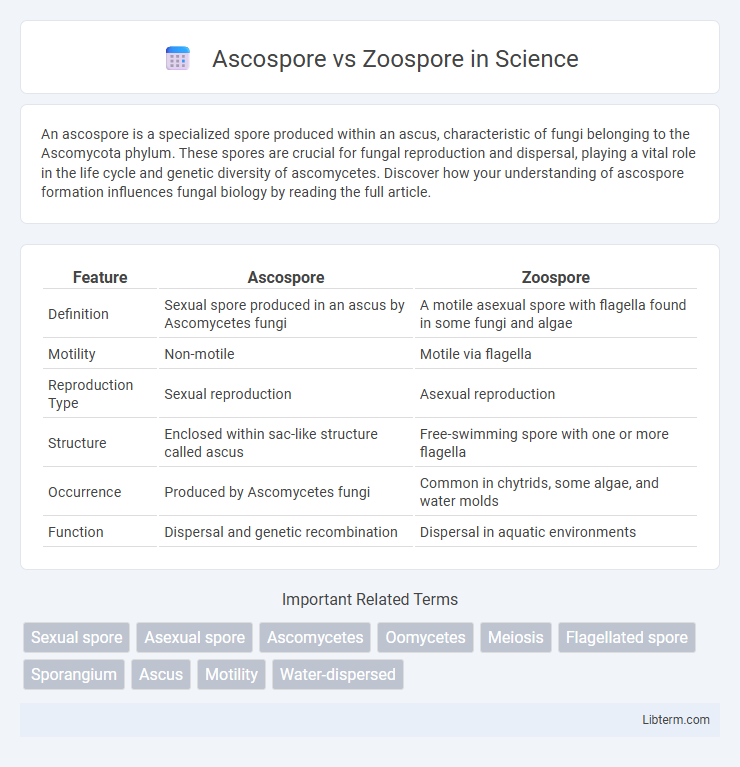An ascospore is a specialized spore produced within an ascus, characteristic of fungi belonging to the Ascomycota phylum. These spores are crucial for fungal reproduction and dispersal, playing a vital role in the life cycle and genetic diversity of ascomycetes. Discover how your understanding of ascospore formation influences fungal biology by reading the full article.
Table of Comparison
| Feature | Ascospore | Zoospore |
|---|---|---|
| Definition | Sexual spore produced in an ascus by Ascomycetes fungi | A motile asexual spore with flagella found in some fungi and algae |
| Motility | Non-motile | Motile via flagella |
| Reproduction Type | Sexual reproduction | Asexual reproduction |
| Structure | Enclosed within sac-like structure called ascus | Free-swimming spore with one or more flagella |
| Occurrence | Produced by Ascomycetes fungi | Common in chytrids, some algae, and water molds |
| Function | Dispersal and genetic recombination | Dispersal in aquatic environments |
Introduction to Ascospores and Zoospores
Ascospores are sexual spores produced inside specialized sac-like structures called asci, typical of Ascomycota fungi, playing a crucial role in fungal reproduction and genetic variation. Zoospores are asexual spores characterized by their motility, equipped with flagella, and are common in certain water molds and algae, enabling rapid dispersal in aquatic environments. Both spore types represent distinct strategies for survival and propagation, reflecting adaptations to different ecological niches.
Definition and Basic Characteristics
Ascospores are sexual spores produced inside an ascus by fungi belonging to the phylum Ascomycota, characterized by their formation through meiosis and subsequent mitotic division, often resulting in eight spores per ascus. Zoospores are asexual, motile spores found in various groups of fungi and algae, equipped with flagella that enable movement in aquatic environments, facilitating dispersal and infection. The fundamental difference lies in their reproductive roles and mobility: ascospores serve in sexual reproduction without motility, while zoospores enable asexual reproduction with active locomotion.
Origin and Formation Process
Ascospores originate from the sexual reproduction of ascomycete fungi through the formation of an ascus, where meiosis followed by mitosis produces typically eight genetically diverse spores enclosed within a sac-like structure. Zoospores arise from asexual reproduction, primarily in aquatic fungi and some protists, formed inside a sporangium and are motile due to the presence of flagella, allowing them to swim in water. The origin of ascospores is linked to genetic recombination and diversity, whereas zoospores emphasize dispersal and rapid colonization in moist environments.
Structural Differences
Ascospores are sexual spores produced inside a sac-like structure called an ascus, typically featuring a thick cell wall and lacking flagella, which makes them non-motile. Zoospores are asexual spores characterized by the presence of one or more flagella, enabling motility in aquatic environments. The main structural difference lies in the ascospore's enclosed, non-motile form versus the free-swimming, flagellated structure of zoospores.
Methods of Dispersal
Ascospores disperse primarily through passive mechanisms such as wind or water, often released from mature fruiting bodies called asci in ascomycete fungi. Zoospores utilize active dispersal by swimming with their flagella in aquatic environments, enabling targeted movement toward suitable substrates or hosts. The difference in dispersal methods reflects adaptations to terrestrial versus aquatic habitats in fungal reproductive strategies.
Environmental Adaptations
Ascospores, produced by fungi in the phylum Ascomycota, possess thick cell walls and resilience to desiccation, enabling survival in harsh terrestrial environments and long-distance dispersal by wind. Zoospores, found in certain water molds and chytrids, are motile spores with flagella that facilitate movement in aquatic and moist habitats, allowing them to locate favorable conditions for growth. The environmental adaptations of ascospores emphasize durability and dispersal in dry or fluctuating conditions, while zoospores exhibit mobility tailored to water-dependent ecosystems.
Roles in Reproduction
Ascospores function as sexual spores produced within an ascus during the reproductive cycle of ascomycete fungi, facilitating genetic recombination and dispersal. Zoospores serve as asexual, motile spores equipped with flagella, enabling aquatic fungi and protists to colonize new environments rapidly through swimming. Both spores play crucial roles in the life cycles of their respective organisms by ensuring survival, genetic diversity, and propagation under varying ecological conditions.
Occurrence in Fungi and Algae
Ascospores primarily occur in Ascomycota fungi, developing within specialized sac-like structures called asci during sexual reproduction. Zoospores are motile spores found mainly in certain algae and lower fungi such as Chytridiomycota, using flagella for movement in aquatic environments. The presence of ascospores signifies sexual reproduction in terrestrial fungi, while zoospores facilitate asexual dispersal in moist or aquatic habitats.
Ecological Significance
Ascospores play a crucial ecological role in decomposing organic matter and recycling nutrients within terrestrial ecosystems, often through symbiotic relationships with plants and fungi. Zoospores, equipped with flagella, facilitate rapid aquatic dispersal, enabling colonization of diverse freshwater and marine habitats and contributing to nutrient cycling. Both spores support ecosystem stability by promoting microbial diversity and aiding in the life cycles of fungi and protists.
Key Differences Summarized
Ascospores are sexual spores produced inside asci of Ascomycota fungi, whereas zoospores are asexual, motile spores found in some algae and fungi like Chytridiomycota. Ascospores possess a tough, non-motile structure adapted for dispersal through air, contrasting with zoospores which have flagella enabling active movement in aquatic environments. The formation of ascospores involves meiosis leading to genetic recombination, while zoospores are formed mitotically, maintaining genetic consistency.
Ascospore Infographic

 libterm.com
libterm.com